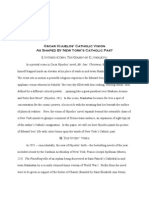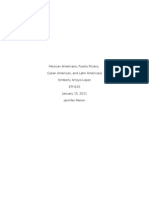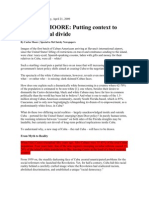Ethnographymain
Ethnographymain
Uploaded by
api-316851329Copyright:
Available Formats
Ethnographymain
Ethnographymain
Uploaded by
api-316851329Original Title
Copyright
Available Formats
Share this document
Did you find this document useful?
Is this content inappropriate?
Copyright:
Available Formats
Ethnographymain
Ethnographymain
Uploaded by
api-316851329Copyright:
Available Formats
Honeycutt 1
Rodney Honeycutt
English 111-98
Ms. Douglas
24 March 2016
Why is Miami Predominantly Hispanic?
The first thing that an outsider would notice about the city of Miami is that the number of
Hispanics completely outweigh the number of such people in other parts of the United States.
There is no question that the majority of this country is white, but why is Miami an outlier?
Based on statistics from 2010-2014 from the U.S. census, Hispanics make up sixty-five percent
of Miami-Dade county as opposed to the nationwide percentage of seventeen percent. The U.S.
census also shows that Spanish is the primary language spoken at home in a similar sixty-five
percent of Miami-Dade County. Whereas English is the primary language spoken at home in
only twenty-six percent of homes in the same county (Miami-Dade County Population and).
These statistics lead back to the question, why is the number of Hispanics an exponential outlier
as opposed to the rest of the United States?
Primary Research
An observer took a trip to Miami to see if there was a noticeable, more populated number
of Hispanics there because if not, the relevance of this ethnography would be nonexistent. The
observer constructed a tally chart for the number of Hispanics, Caucasians, and other ethnic
groups and set observing areas in Miami-Dade County where he would put together his research.
These places consisted of a restaurant in downtown Miami named Duffys, the condo complex in
which the observer was staying with the name Intracoastal Yacht Club, and a vicinity on the
Honeycutt 2
beach of South Beach (these findings may be skewed as they were placed into ethnic group
categories solely on visuals and good judgement). The findings are recorded below.
Group
Duffys
Intracoastal
South Beach
Total
Hispanic
Caucasian
African-
Restaurant
21
12
14
Yacht Club
12
17
6
32
17
12
65
46
32
American
Total
47
35
61
143
The observers findings prove the statement that Hispanics are more eminent in the
Miami-Dade area as opposed to the rest of the country, provided that the U.S. Census is correct
with its statement that Hispanics make up twelve percent of the nations population. Even though
the size of this study group is substantially smaller than the Miami-Dade County population, the
statistics coincide with the U.S. Census statistics. Although this primary research proves that
Hispanics are more relevant in Miami it does not tell us why.
Secondary Research
The term Hispanic refers to persons of Spanish-speaking origin or ancestry, because
this a broad spectrum of people it becomes extremely difficult to pinpoint a specific reason as to
why Hispanics as a whole are located in Miami. For that reason, the researcher must narrow that
spectrum of people. According the same U.S. census mentioned earlier, Cubans make up fiftyfour percent of Hispanics in Miami-Dade County. Within the Cuban-American population of
over one million in the state of Florida alone (Vogel), researchers are kept busy tracking waves of
movement.
Honeycutt 3
The first large wave of Cuban immigration came in the years 1959 and 1960. This was
mainly for political reasons. In 1959, Fidel Castro and his Communist regime took over Cuba.
During his rule, the conditions of life, especially economically, worsened to the point where
Cubans fled seeking jobs and a better life. Almost all of these immigrants fled to the southern
coast of Florida which was just across the Atlantic from Cuba. Most of this wave of Floridas
newest residents settled in the city of Miami, where there is actually a section called Little
Havana, named after Cubas capital. During this wave of immigration about 250,000 Cuban
immigrants arrived in the United States (Moments in U.S. Diplomatic).
Another flood of Cuban immigration came in 1980 due to the Mariel boatlift. The Mariel
boatlift began when several Cubans took control of a bus and drove it through a fence of the
Peruvian embassy in Havana. They requested, and were granted, political asylum from Fidel
Castros communist ways. On the first of April of 1980, Castro stated that the port of Mariel,
which was just outside of Havana, would be opened to anyone wishing to leave Cuba given that
they had a ride waiting to pick them up (Waves of Cuban). Castro even allowed thousands of
criminals and mental patients to leave as well. Many Cuban exiles from the first wave of 1959
rushed to Southern Florida (Key West and Miami especially) to hire boats to transport family and
friends from the port of Mariel back to Southern Florida since that would be the shortest and
cheapest distance from Cuba. This began a six-month drama where more than 125,000 Cubans
left their country and overwhelmed the Florida coast (Waves of Cuban). The Mariel boatlift
reached an end by mutual agreement from the United States and Cuba. Florida took the biggest
hit from these events when crime drastically increased for years after the mass migration. The
movie Scarface provides a great depiction of the aftermath as the crime wave in Miami served as
a major influence for one of the greatest films of all time.
Honeycutt 4
Conclusion
There is no debate that the Hispanic population in Southern Florida, specifically Miami,
is substantially greater than the Hispanic population anywhere else in the United States. This is
backed up with primary and secondary research. The secondary research shows multiple and
specific events where Hispanics migrated to the state of Florida.
To this day, immigration to the southern coast of Florida by Hispanics is still largely
present. The current high number of Hispanics in Southern Florida adds another, and very
simple, reason for more Hispanics to migrate there, their people are there.
Honeycutt 5
Works Cited
"Miami-Dade County Population and Races." Miami-Dade County, FL Population and Races.
USA.com. Web. 24 Mar. 2016.
"Moments in U.S. Diplomatic History." Association for Diplomatic Studies and Training. Web.
24 Mar. 2016.
Vogel, Mike. "Snapshots of Florida's Hispanic Community." Florida Trend. 30 Apr. 2013. Web.
24 Mar. 2016
Waves of Cuban Immigrants." The Advocates For Human Rights. Energy of a Nation:
Immigration Resources. Web. 24 Mar. 2016.
Honeycutt 6
You might also like
- State of Resistance: What California’s Dizzying Descent and Remarkable Resurgence Mean for America’s FutureFrom EverandState of Resistance: What California’s Dizzying Descent and Remarkable Resurgence Mean for America’s FutureNo ratings yet
- Oscar Hijuelos' Catholic Imagination in Mr. Ives' ChristmasDocument12 pagesOscar Hijuelos' Catholic Imagination in Mr. Ives' ChristmasJoseph L. GrabowskiNo ratings yet
- Excerpt From "Latino America" by Matt Marreto and Gary Segura.Document10 pagesExcerpt From "Latino America" by Matt Marreto and Gary Segura.OnPointRadioNo ratings yet
- Contested Boundaries) Benjamin Bryce, Alexander Freund-Entangling Migration History - Borderlands and Transnationalism in The United StaDocument247 pagesContested Boundaries) Benjamin Bryce, Alexander Freund-Entangling Migration History - Borderlands and Transnationalism in The United StaSomarkk100% (1)
- Grade 8 Source 1jDocument3 pagesGrade 8 Source 1japi-233875667No ratings yet
- KULT - Divinity Lost - Quickplay Scenario - La CenaDocument15 pagesKULT - Divinity Lost - Quickplay Scenario - La Cenapacalypse100% (1)
- Full Survey - Cuban Americans 2021Document64 pagesFull Survey - Cuban Americans 2021Bianca PadroNo ratings yet
- It's Your Turn in The Sun - Printout - TIMEDocument5 pagesIt's Your Turn in The Sun - Printout - TIMEbeatriz0318No ratings yet
- Hispanic Immigration Threatens To Divide America PDFDocument4 pagesHispanic Immigration Threatens To Divide America PDFpiperezNo ratings yet
- Davis M - Magical Urbanism - Latinos Reinvent The US Big CityDocument41 pagesDavis M - Magical Urbanism - Latinos Reinvent The US Big CityzvonomirNo ratings yet
- David Escobar: The Invisible Indians of CaliforniaDocument3 pagesDavid Escobar: The Invisible Indians of Californiaapi-424635303No ratings yet
- Flores - Nueva York, Diaspora CityDocument6 pagesFlores - Nueva York, Diaspora CityMismo AleNo ratings yet
- America's Alien Invasion:: Drawing Aside The Purple CurtainDocument14 pagesAmerica's Alien Invasion:: Drawing Aside The Purple CurtainbagheeraNo ratings yet
- Chap 06Document24 pagesChap 06api-240900456No ratings yet
- I Miami: The Miami Cuban CommunityDocument26 pagesI Miami: The Miami Cuban CommunitylzeeNo ratings yet
- Hispanic AmericansDocument6 pagesHispanic Americansgantts081906100% (2)
- A Day Without A Mexican AnalysisDocument15 pagesA Day Without A Mexican AnalysisJosé Eduardo V GrailletNo ratings yet
- Magical Urbanism Latinos Reinvent The US B - Mike DavisDocument41 pagesMagical Urbanism Latinos Reinvent The US B - Mike DaviskeithholdichNo ratings yet
- The Golden Door: International Migration, Mexico, and the United StatesFrom EverandThe Golden Door: International Migration, Mexico, and the United StatesNo ratings yet
- American Academy of Political and Social ScienceDocument10 pagesAmerican Academy of Political and Social ScienceWarren Bradley ClarkeNo ratings yet
- Extra RegDocument4 pagesExtra RegShirmara Pile-fordeNo ratings yet
- Only a Few Blocks to Cuba: Cold War Refugee Policy, the Cuban Diaspora, and the Transformations of MiamiFrom EverandOnly a Few Blocks to Cuba: Cold War Refugee Policy, the Cuban Diaspora, and the Transformations of MiamiNo ratings yet
- Cultural ImmersionDocument12 pagesCultural Immersionapi-287976196No ratings yet
- Poverty-War On Drugs-Migration To UsDocument26 pagesPoverty-War On Drugs-Migration To Usapi-275304033No ratings yet
- Anything But Mexican: Chicanos in Contemporary Los AngelesFrom EverandAnything But Mexican: Chicanos in Contemporary Los AngelesNo ratings yet
- Fences and Xenophobes: Etter From AmericaDocument2 pagesFences and Xenophobes: Etter From AmericasatyabashaNo ratings yet
- Balseros: Those Who Gave Up and Left Cuba, IIDocument26 pagesBalseros: Those Who Gave Up and Left Cuba, IIlzeeNo ratings yet
- Ethnic Minorities in The UsaDocument5 pagesEthnic Minorities in The UsaTīzīrī ĔşpiNo ratings yet
- Undocumented Migration From Latin America Inaneraof Rising U.S. EnforcementDocument28 pagesUndocumented Migration From Latin America Inaneraof Rising U.S. EnforcementcosquillamorenaNo ratings yet
- Social Sciences: Not Haitian: Exploring The Roots of Dominican IdentityDocument12 pagesSocial Sciences: Not Haitian: Exploring The Roots of Dominican IdentityIvetty EstepanNo ratings yet
- Answers CHP 10Document5 pagesAnswers CHP 10Jafin100% (1)
- How The Irish Becomes Part of White' Americans: A SurveyDocument6 pagesHow The Irish Becomes Part of White' Americans: A SurveyThoby PramuditoNo ratings yet
- Diaspora Colombiana en InglesDocument19 pagesDiaspora Colombiana en InglesGermán HerreraNo ratings yet
- Impact of Caribbean Culture On Extra Regional SocietiesDocument7 pagesImpact of Caribbean Culture On Extra Regional SocietiesNiceann100% (4)
- Everything You Need to Know About Latino History: 2008 EditionFrom EverandEverything You Need to Know About Latino History: 2008 EditionNo ratings yet
- Eth125 7Document9 pagesEth125 7Kchanchef89No ratings yet
- MacoDocument56 pagesMacotropNo ratings yet
- Deported Immigrant Policing Disposable Labor and Global CapitalismDocument316 pagesDeported Immigrant Policing Disposable Labor and Global Capitalismmsadooq0% (1)
- Latino Americans G2docxDocument11 pagesLatino Americans G2docxMyyne 30No ratings yet
- Latinos in New York: Communities in TransitionFrom EverandLatinos in New York: Communities in TransitionSherrie BaverNo ratings yet
- Research Paper Topics Latin American HistoryDocument6 pagesResearch Paper Topics Latin American Historyc9r0s69n100% (2)
- La Times 2003Document2 pagesLa Times 2003Geoffrey FoxNo ratings yet
- Năm 4 cô hảiDocument11 pagesNăm 4 cô hảiNguyệt NguyễnNo ratings yet
- If We Want to Win: A Latine Vision for a New American DemocracyFrom EverandIf We Want to Win: A Latine Vision for a New American DemocracyDiana CampoamorNo ratings yet
- Race and EthnicityDocument27 pagesRace and EthnicityAnarghyaNo ratings yet
- Origins and Destinies: Immigration To The United States Since World War IIDocument39 pagesOrigins and Destinies: Immigration To The United States Since World War IInotorjNo ratings yet
- Life in The Hyphen STAVANSDocument13 pagesLife in The Hyphen STAVANSangelmdiazNo ratings yet
- The Economic State of The Latino Community in AmericaDocument26 pagesThe Economic State of The Latino Community in AmericaLatino Rebels100% (1)
- Economic Reality of Hispanics in The United StatesDocument17 pagesEconomic Reality of Hispanics in The United Stateslatb1999No ratings yet
- Latino America-The Nations Important SubcultureDocument17 pagesLatino America-The Nations Important SubcultureYoon Eun JiNo ratings yet
- Human Rights in A Globalizing World: Who Pays The Human Cost of Migration?Document13 pagesHuman Rights in A Globalizing World: Who Pays The Human Cost of Migration?amo_ana2005No ratings yet
- Melting Pot or Salad BowlDocument22 pagesMelting Pot or Salad Bowlvolo1234bookNo ratings yet
- 6 Cuban AmericansDocument59 pages6 Cuban AmericansGlecy EusalaNo ratings yet
- REVISED PAPER Doc (2) - 240107 - 000556Document9 pagesREVISED PAPER Doc (2) - 240107 - 000556nadasafaeva5No ratings yet
- Essay IiDocument7 pagesEssay Iiluisiko9797No ratings yet
- Research Paper Topics Latin AmericaDocument7 pagesResearch Paper Topics Latin Americaafnhdqfvufitoa100% (1)
- A Flood of Mexicans Inmigration 1940 - 80Document14 pagesA Flood of Mexicans Inmigration 1940 - 80api-27524181No ratings yet
- Dream Builders, Dream Killers: Voice of an Immigrant from HaitiFrom EverandDream Builders, Dream Killers: Voice of an Immigrant from HaitiNo ratings yet
- Writing Assignment 2Document5 pagesWriting Assignment 2api-318167408No ratings yet
- BendixenAndAmandi ElNuevoHerald TheMiamiHerald TampaBayTimes Cuban-American-Flash-PollDocument63 pagesBendixenAndAmandi ElNuevoHerald TheMiamiHerald TampaBayTimes Cuban-American-Flash-PollAlan Farago100% (1)
- Coser y Cantar. Theor. Quotes PDFDocument4 pagesCoser y Cantar. Theor. Quotes PDFJimmy Poot MayNo ratings yet
- YÖKDİL Sosyal Bilimler Deneme Sınavı 2Document20 pagesYÖKDİL Sosyal Bilimler Deneme Sınavı 2Ssali BbirkNo ratings yet
- UntitledDocument2 pagesUntitledAna NavarroNo ratings yet
- FL-26 Dario Moreno For David Rivera (Sept. 2012)Document5 pagesFL-26 Dario Moreno For David Rivera (Sept. 2012)Daily Kos ElectionsNo ratings yet
- Santeria - From Africa To Miami Via Cuba Five Hundred Years of Worship (Diana Gonzalez Kirby & Sara Maria Sanchez) PDFDocument17 pagesSanteria - From Africa To Miami Via Cuba Five Hundred Years of Worship (Diana Gonzalez Kirby & Sara Maria Sanchez) PDFyama narakaNo ratings yet
- Impact of Caribbean Culture On Extra Regional SocietiesDocument7 pagesImpact of Caribbean Culture On Extra Regional SocietiesLatt001No ratings yet
- Miami Herald EEditionDocument4 pagesMiami Herald EEditionGonzalo Alonso LabragaNo ratings yet
- Immigration Is Changing The Political Landscape in Key StatesDocument14 pagesImmigration Is Changing The Political Landscape in Key StatesCenter for American ProgressNo ratings yet
- EthnographymainDocument6 pagesEthnographymainapi-316851329No ratings yet
- Iaadfs 2011 SMALLDocument165 pagesIaadfs 2011 SMALLchris2541No ratings yet
- Latino Group Consciousness and Political ParticipationDocument19 pagesLatino Group Consciousness and Political ParticipationMagda BoNo ratings yet
- Cuba in A Global ContextDocument350 pagesCuba in A Global Contextyylf2016100% (1)
- Impact of Caribbean Culture On Extra Regional SocietiesDocument7 pagesImpact of Caribbean Culture On Extra Regional SocietiesNiceann100% (4)
- Muñoz - No Es Fácil - Notes On The Negotiation of Cubanidad and Exilic Memory in Carmelita Tropicana's Milk of AmnesiaDocument7 pagesMuñoz - No Es Fácil - Notes On The Negotiation of Cubanidad and Exilic Memory in Carmelita Tropicana's Milk of AmnesiaMariana Olivares100% (1)
- Economy AdvDocument21 pagesEconomy AdvLeo KimNo ratings yet
- 2020 Post-Mortem PART ONE: Portrait of A Persuadable LatinoDocument63 pages2020 Post-Mortem PART ONE: Portrait of A Persuadable LatinoLatino RebelsNo ratings yet
- Duty, Tradition, and Cultural Division in Eduardo Machado's The CookDocument6 pagesDuty, Tradition, and Cultural Division in Eduardo Machado's The CookdylanmjusticeNo ratings yet
- TOEFL Test 1Document24 pagesTOEFL Test 1Hammam MuwaffaqNo ratings yet
- Carlos MooreDocument19 pagesCarlos MooresithmaulNo ratings yet
- Letter To Pres Biden From Reps Rush, Cohen, Lee, Moore Et Al RE Cuba PolicyDocument8 pagesLetter To Pres Biden From Reps Rush, Cohen, Lee, Moore Et Al RE Cuba PolicyCongressmanRushNo ratings yet
- Social Work Practice With Latinos-PpDocument21 pagesSocial Work Practice With Latinos-Ppochoajulie87No ratings yet
- Magical Urbanism Latinos Reinvent The US B - Mike DavisDocument41 pagesMagical Urbanism Latinos Reinvent The US B - Mike DaviskeithholdichNo ratings yet
- From Havana To Miami U.S. Cuba Policy As A Two-Level GameDocument21 pagesFrom Havana To Miami U.S. Cuba Policy As A Two-Level GameAlessio MirarchiNo ratings yet
- 2015 Cri Conference Final ProgramDocument45 pages2015 Cri Conference Final ProgramA MaderNo ratings yet
- Answers CHP 10Document5 pagesAnswers CHP 10Jafin100% (1)
- 2007 Interviews1 EnglischDocument182 pages2007 Interviews1 EnglischelstaquioNo ratings yet






















































































